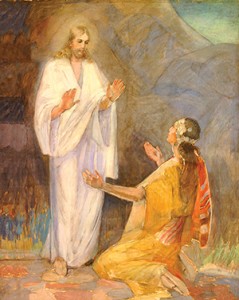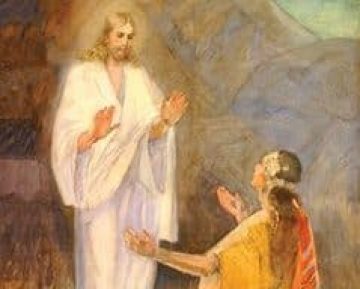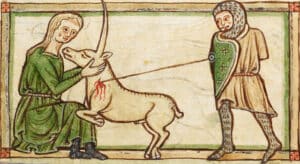The Atonement and Resurrection of Jesus Christ
Opening Hymn: Where can I turn for peace?
Closing Hymn: I need thee every hour
 I love this topic and I wish it were broken down into many different lessons to be enjoyed throughout the year. Who can rejoice too much or study too often the Savior and the Atonement? Of all the potentially fraught lessons we might have, surely this topic has the greatest potential to bring peace, healing and love to the classroom. Hooray!
I love this topic and I wish it were broken down into many different lessons to be enjoyed throughout the year. Who can rejoice too much or study too often the Savior and the Atonement? Of all the potentially fraught lessons we might have, surely this topic has the greatest potential to bring peace, healing and love to the classroom. Hooray!
The material in the manual is rich and could be approached in many different ways. One approach would be to spend the lesson discussing repentance and the Resurrection. The Exponent has many great posts and lesson plans on these topics, so if you’re interested in pursuing those specific topics, use our search tool in the top right corner!
Instead I am going to focus on two aspects of President Howard W. Hunter’s teachings that struck me as being particularly meaningful for women, and perhaps getting less attention when we discuss the Atonement.
Bearing Witness
President Hunter refers three times in this lesson to Mary Magdalene and other women being the first to see the Savior rise from the tomb, and to bear testimony of the resurrection.
From the manual:
When the women came to the tomb, they found it open and empty. The angels had tarried to tell them the greatest news ever to fall on human ears: “He is not here: for he is risen, as he said” (Matthew 28:6). No doctrine in the Christian canon is more important . . . than the doctrine of the resurrection of the Son of God.
- Why do you think the Savior appeared first to women? Was it coincidence?
- What does it mean to you that we owe our first witness of the resurrection to women?
Initially, Mary struggled to convince the other apostles that the Lord had indeed risen.
Now when Jesus was risen early the first day of the week, he appeared first to Mary Magdalene, out of whom he had cast seven devils. And she went and told them that had been with him, as they mourned and wept. And they, when they had heard that he was alive, and had been seen of her, believed not. (Mark 16:9-11)
- Have you ever faced difficulty in persuading leaders of the importance of a spiritual prompting you’ve received?
- What can we learn from Mary’s example?
- Why do you think President Hunter emphasized the importance of Mary’s discipleship?
Pain and Mercy
President Hunter taught that the Atonement allowed the Savior to feel everything that we feel. He cited Alma 7:11-12
He shall go forth, suffering pains and afflictions and temptations of every kind; and this that the word might be fulfilled which saith he will take upon him the pains and the sicknesses of his people. And he will take upon him death, that he may loose the bands of death which bind his people; and he will take upon him their infirmities, that his bowels may be filled with mercy, according to the flesh, that he may know according to the flesh how to succor his people according to their infirmities.
- What other words can we use along with “infirmities” to better understand this scripture?
- What are some experiences that you can only understand and help someone if you’ve been there yourself?
From the manual:
He, the sinless Son of God, had already taken upon him not only the sins and temptations of every human soul who will repent, but all of our sickness and grief and pain of every kind. He suffered these afflictions as we suffer them, according to the flesh. He suffered them all. He did this to perfect his mercy and his ability to lift us above every earthly trial.
For some reason, I feel that I was not aware of that aspect of the Atonement until I was in my twenties. Yet I think it is perhaps the most constant part of the Savior’s mission in our day to day lives. We hunger for knowledge of the Resurrection in times of grief. We need to repent to be with God and to feel at peace, but often that repentence happens later, in prayer and reflection. In contrast, the need for comfort and understanding is immediate. We long for a friend and support right now, in the moment.
President Hunter cites the words to “I stand all amazed” which could be a powerful hymn to choose to sing. My own preference would be to share Emma Lou Thayne’s hymn Where can I turn for peace.
What I love about the hymn is that it personalizes the Atonement and ties our suffering intimately with the Savior’s. The third verse highlights this: “[He] reaches my reaching, in my Gethsemane, Savior and Friend.” (emphasis added)
If I were in Relief Society, I would love to have a really meaningful discussion about what our Gethsemanes have been, and how (or if) we felt the Savior’s reaching hand. I realize that this level of vulnerability may not work in all wards. Breaking the room into smaller groups may foster intimacy and trust to have a more personal conversation. I think sharing excerpts from Chieko Okazaki’s words on the Atonement from Lighten Up could be helpful either in facilitating vulnerability, or as a means of personalizing and feminizing the Atonement for groups where sharing may not work. I’ve included the long passage from her book at the end of this post.
Take a moment to think of a time in your life you would consider your Gethsemane – the darkest, hardest, saddest hour.
- What was comforting to you in that time?
- Have you struggled to believe that the Savior has shared your personal experiences?
- It is likely that some of these moments will be related to the death of loved ones. Select in advance a relevant quote about the Resurrection from the manual to tie in to the discussion.
Read part or all of the Chieko Okazaki quote below and make a list of some of the examples she cites on the board.
- Have class members imagine the specifics of a given situation – how might a grandmother feel to learn her grandbaby has Down syndrome? What thoughts would cross her mind?
- Temple sealing is supposed to be a wonderful thing. But if you’re a widow or divorced, thinking about it can bring a sense of loss. What feelings might a woman in that situation have?
- How can the Savior and a testimony of the Atonement offer comfort in those situations?
Sister Okazaki brings up experiences that are specifically female, for example rape, abortion, PMS, menopause.
- How does it change your view of the Atonement to feel Christ understands an experience that men have never had?
- Do you struggle to feel that Christ, having never been a woman, can truly understand something like miscarriage or other female experiences? How do you cope with such feelings?
- How could men benefit from Christ’s example of understanding the feminine experience? How could we as a church and community create a culture where men emulate the Savior in this way?
Chieko Okazaki from Lighten Up! p. 174:
Well, my dear sisters, the gospel is the good news that can free us from guilt. We know that Jesus experienced the totality of mortal existence in Gethsemane. It’s our faith that he experienced everything- absolutely everything. Sometimes we don’t think through the implications of that belief.
We talk in great generalities about the sins of all humankind, about the suffering of the entire human family. But we don’t experience pain in generalities. We experience it individually. That means he knows what it felt like when your mother died of cancer- how it was for your mother, how it still is for you. He knows what it felt like to lose the student body election. He knows that moment when the brakes locked and the car started to skid. He experienced the slave ship sailing from Ghana toward Virginia. He experienced the gas chambers at Dachau. He experienced Napalm in Vietnam. He knows about drug addiction and alcoholism.
Let me go further. There is nothing you have experienced as a woman that he does not also know and recognize. On a profound level, he understands the hunger to hold your baby that sustains you through pregnancy. He understands both the physical pain of giving birth and the immense joy. He knows about PMS and cramps and menopause. He understands about rape and infertility and abortion. His last recorded words to his disciples were, ‘And, lo, I am with you always, even unto the end of the world.’ (Matthew 28:20)
He understands your mother-pain when your five-year-old leaves for kindergarten, when a bully picks on your fifth-grader, when your daughter calls to say that the new baby has Down syndrome. He knows your mother-rage when a trusted babysitter sexually abuses your two-year-old, when someone gives your thirteen-year-old drugs, when someone seduces your seventeen-year-old.
He knows the pain you live with when you come home to a quiet apartment where the only children are visitors, when you hear that your former husband and his new wife were sealed in the temple last week, when your fiftieth wedding anniversary rolls around and your husband has been dead for two years. He knows all that. He’s been there. He’s been lower than all that. He’s not waiting for us to be perfect. Perfect people don’t need a Savior. He came to save his people in their imperfections.
He is the Lord of the living, and the living make mistakes. He’s not embarrassed by us, angry at us, or shocked. He wants us in our brokenness, in our unhappiness, in our guilt and our grief. You know that people who live above a certain latitude and experience very long winter nights can become depressed and even suicidal, because something in our bodies requires whole spectrum light for a certain number of hours a day. Our spiritual requirement for light is just as desperate and as deep as our physical need for light. Jesus is the light of the world.
We know that this world is a dark place sometimes, but we need not walk in darkness. The people who sit in darkness have seen a great light, and the people who walk in darkness can have a bright companion. We need him, and He is ready to come to us, if we’ll open the door and let him.
This lesson plan was originally published on February 23, 2016 as Relief Society Lesson 6: The Atonement and Resurrection of Jesus Christ.






4 Responses
This lesson is so lovely and includes some of my favorite leaders, President Hunter, President Okazaki, and Emma Lou Thayne. Thank you for this!
Thanks!
You don’t know where to find the Okazaki quote translated into Spanish, do you? I’ll be teaching in Spanish and recognize that my own translation would lack polish.
Thank you so much! I used some of your ideas and the Pesident Okazaki qyote really hit home & touched all the women in my class. Thanks again